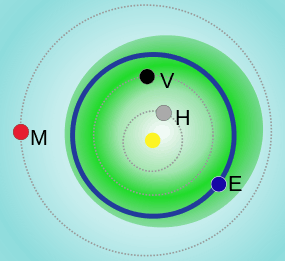1991 VG
| Discovery[1] | |
|---|---|
| Discovered by | Steward Observatory (691) |
| Discovery date | November 6, 1991 |
| Designations | |
| MPC 28316 | |
Apollo  NEO | |
| Orbital characteristics[2] | |
| Epoch 13 January 2016 (JD 2457400.5) | |
| Uncertainty parameter 2 | |
| Observation arc | 173 |
| Aphelion | 1.0773277 AU (161.16593 Gm) |
| Perihelion | 0.97637190 AU (146.063157 Gm) |
| 1.0268498 AU (153.61454 Gm) | |
| Eccentricity | 0.0491580 |
|
1.04 yr (380.07 d) 1.04 y | |
| 36.52549° | |
| 0.9472044°/day | |
| Inclination | 1.445423° |
| 73.97696° | |
| 24.62597° | |
| Earth MOID | 0.00456161 AU (682,407 km) |
| Jupiter MOID | 3.93083 AU (588.044 Gm) |
| Physical characteristics | |
| Dimensions | 5–12 m (15–40 ft)[3] |
| 28.5[2] | |
|
| |
1991 VG is a near-Earth object discovered by American astronomer James Scotti on 6 November 1991, using the Spacewatch Telescope on Kitt Peak.[4]
Earth-like orbit
On November 6, 1991, Scotti discovered a faint object which was designated 1991 VG soon after discovery.[5] The object's heliocentric orbit was found to be very similar to Earth's orbit[6] and it was calculated that it would make a close approach to Earth just a month after discovery (on December 5, 1991[2]). Given such an Earth-like orbit, the dynamical lifetime of such an object is relatively short with the object quickly either impacting Earth or being perturbed by Earth onto a different orbit. The similarity of its orbit with Earth was also very difficult to explain from natural sources, with ejecta from a recent Lunar impact or non-gravitational perturbations such as the Yarkovsky effect having been suggested.[7] The first Earth Trojan asteroid, 2010 TK7, was later identified and such objects could well be a source for objects like 1991 VG.
Possible monolithic structure
Since the discovery of 1991 VG, about 80% of small asteroids with absolute magnitudes (H) fainter than 22.0 (corresponding to sizes smaller than about 200 meters) which have had their lightcurve measured have rotation periods under 2 hours. Such rapid rotation rates are typically associated with asteroids that are monolithic bodies or welded conglomerates having sufficient intrinsic strength to counteract centrifugal forces. More slowly rotating asteroids are sometimes gravitationally bound aggregates.[8]
Possible artificial origin
The uncertainty of the object's origin, combined with rapid variation in the object's brightness in images obtained during its close passage with Earth in early December 1991, led to some speculation that 1991 VG might be a spent rocket fuel tank.[9][10] There was speculation that it could be a rocket body from a satellite launched in the early 1970s,[9][11] or from Apollo 12 mission.[11]
References
- ↑ "1991 VG". Minor Planet Center. 27 April 1992.
- 1 2 3 "JPL Small-Body Database Browser: (1991 VG)" (last observation: 1992-04-27; arc: 173 days). Jet Propulsion Laboratory. Retrieved 29 March 2016.
- ↑ "ABSOLUTE MAGNITUDE (H)". NASA.
- ↑ Steel, Duncan (April 1995). "SETA and 1991 VG". The Observatory. 115, p. 78-83. Retrieved 2016-08-28 – via Harvard.
- ↑ satobs.org: James Scotti, Re: What is 1991 VG?
- ↑ jpl.nasa.gov, 1991 VG Earth Impact Risk Summary
- ↑ Steele, D. (1995). "SETA and 1991 VG". The Observatory. 115: 78–83. Bibcode:1995Obs...115...78S.
- ↑ Hergenrother, C. W.; Whiteley, R. J. (2011). "A survey of small fast rotating asteroids among the near-Earth asteroid population". Icarus. 214: 194. Bibcode:2011Icar..214..194H. doi:10.1016/j.icarus.2011.03.023.
- 1 2 Scotti, Jim (17 Jul 1996). "What is 1991 VG?". SatObs. Retrieved 2016-03-17.
- ↑ SETA and 1991 VG. Steel, D. Journal: The Observatory, vol. 115, p. 78-83 (1995) Bibliographic Code: 1995Obs...115...78S
- 1 2 Zolfagharifard, Ellie (27 October 2015). "Is this an 'alien probe'? Strange object set to sweep past Earth in 2017 (but it may just be space junk from the Apollo 12 mission)". Daily Mail. Retrieved 2016-03-17.